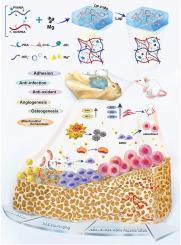A H2-bioreactor for mitochondrial rehabilitation in infected bone defects regeneration
IF 10.2
1区 医学
Q1 ENGINEERING, BIOMEDICAL
引用次数: 0
Abstract
The repair of infected bone defects (IBDs) presents a significant clinical challenge due to recurrent infections and inflammation. Characterized by reactive oxygen species (ROS) bursts and mitochondrial dysfunction, IBDs generates to a vicious oxidation-inflammation cycle that impairs bone remodeling. To address this, we developed a double-network hydrogel scaffold composed of phenylboronic acid-modified quaternary chitosan and glycidyl methacrylated poly(vinyl alcohol) (QP-P), crosslinked via dynamic boronic ester bonds and covalent bonds, loaded with magnesium microspheres (Mg spheres) (QP-P/Mg). This double-crosslinking network confers excellent injectability and tissue adhesion while integrating potent antibacterial, ROS-scavenging, pro-angiogenic, and osteogenic functions. Notably, Mg spheres enable controlled hydrolysis through a boronic ester-magnesium ion (Mg2+) complexation mechanism, providing sustained release of hydrogen (H2) and Mg2+, with H2 potently alleviating oxidative stress and restoring mitochondrial homeostasis via the Nrf2/HO-1 pathway and Mg2+ promoting vascularized bone regeneration. In a rat IBDs model, QP-P/Mg achieved substantial bone regeneration, with a BV/TV ratio of 45.32 % ± 8.22 % after 4 weeks, representing a 6.27-fold improvement over controls. These findings underscore the potential of this H2-releasing hydrogel scaffold with multifunctional properties to promote vascularized bone regeneration in IBDs through ROS elimination and mitochondrial rehabilitation, offering promising clinical translational opportunities for the treatment of IBDs.

h2 -生物反应器用于感染性骨缺损再生的线粒体康复
由于复发性感染和炎症,感染性骨缺损(IBDs)的修复提出了一个重大的临床挑战。IBDs以活性氧(ROS)爆发和线粒体功能障碍为特征,产生恶性氧化-炎症循环,损害骨重塑。为了解决这个问题,我们开发了一种双网络水凝胶支架,由苯基硼酸改性季壳聚糖和甲基丙烯酸缩水甘油酯聚乙烯醇(QP-P)组成,通过动态硼酯键和共价键交联,负载镁微球(Mg球)(QP-P/Mg)。这种双交联网络具有良好的注射性和组织粘附性,同时整合了有效的抗菌、清除活性氧、促血管生成和成骨功能。值得注意的是,镁球通过硼酯-镁离子(Mg2+)络合机制实现可控水解,提供氢(H2)和Mg2+的持续释放,H2通过Nrf2/HO-1途径有效缓解氧化应激和恢复线粒体稳态,Mg2+促进血管化骨再生。在大鼠IBDs模型中,QP-P/Mg实现了大量的骨再生,4周后BV/TV比为45.32%±8.22%,比对照组提高了6.27倍。这些发现强调了这种具有多功能特性的h2释放水凝胶支架通过ROS消除和线粒体康复促进ibd血管化骨再生的潜力,为ibd的治疗提供了有希望的临床转化机会。
本文章由计算机程序翻译,如有差异,请以英文原文为准。
求助全文
约1分钟内获得全文
求助全文
来源期刊

Materials Today Bio
Multiple-
CiteScore
8.30
自引率
4.90%
发文量
303
审稿时长
30 days
期刊介绍:
Materials Today Bio is a multidisciplinary journal that specializes in the intersection between biology and materials science, chemistry, physics, engineering, and medicine. It covers various aspects such as the design and assembly of new structures, their interaction with biological systems, functionalization, bioimaging, therapies, and diagnostics in healthcare. The journal aims to showcase the most significant advancements and discoveries in this field. As part of the Materials Today family, Materials Today Bio provides rigorous peer review, quick decision-making, and high visibility for authors. It is indexed in Scopus, PubMed Central, Emerging Sources, Citation Index (ESCI), and Directory of Open Access Journals (DOAJ).
 求助内容:
求助内容: 应助结果提醒方式:
应助结果提醒方式:


